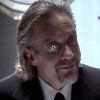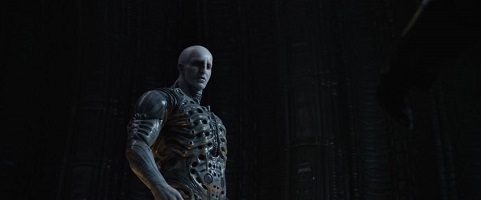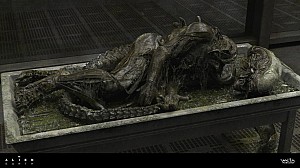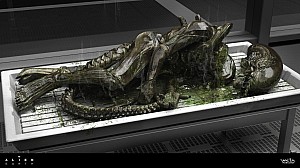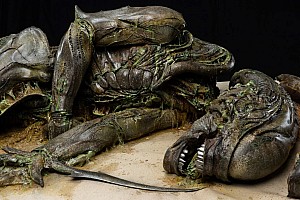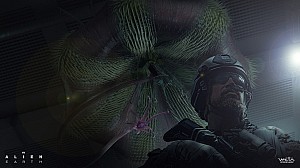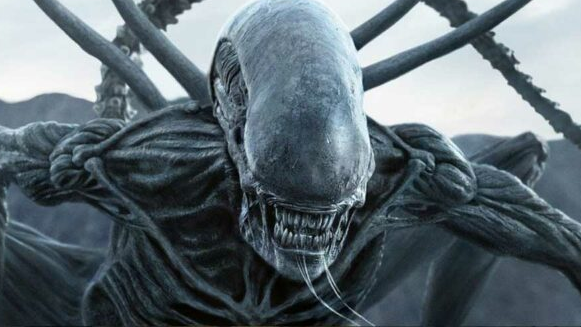The Secret History of the Never-Filmed Aliens Sequel
Alien: Covenant Forum Topic
Ati
MemberPraetorianOct 25, 20176211 Views15 RepliesThe Secret History of William Gibson’s Never-Filmed Aliens Sequel
One of the many problems with Alien 3 was its lack of escalation. (…)
But there’s an alternate universe where the series’ propulsive momentum only increased — a reality in which the third Alien film featured advanced xenomorphs exploding in batches of half a dozen from people’s legs, stomachs, and mouths; where cold-warring rival space stations of communists and capitalists race to outdo one another with their genetic experiments on the aliens’ tissue; where a flock of the phallic horrors flies through the void of space, only to be beaten back by a gun-toting robot. Oh, and there’s a thing called the New Beast that emerges from and sheds a shrieking human’s body as it “rips her face apart in a single movement, the glistening claws coming away with skin, eyes, muscle, teeth, and splinters of bone.”
This is the alternate universe where legendary science-fiction writer William Gibson’s Alien III (that’s “III,” not “3”) screenplay was realized. (…)
You can find the screenplay in an antiquated .txt file online, and there have been occasional discussions of it on message boards and niche blogs, but for whatever reason, it hasn’t been appropriately acknowledged as the remarkable genre-fiction artifact that it is. Indeed, with studio backing and the right production team, one can imagine the finished film being on par with Alien and Aliens, and it certainly would have altered the course of the franchise’s history. With the arrival of Alien Covenant — a movie that, whatever its merits, largely retreads ideas from the series’ previous installments — it’s time to tell the story of how Gibson’s Alien III came to be, why it never crossed the finish line, and what made it special.
In the latter half of 1987, Gibson got a call from the producers and he was flown to L.A. to talk it all out over dinner. Giler and Hill had been contemplating the notion of a communist faction in space as a possible aspect of a third Alien, and they presumably brought that up, though Gibson says he doesn’t “remember anything about it other than being told that Ripley wasn’t to be a character.” Weaver has said she didn’t want to participate in any significant way because she “felt Ripley was going to become a burden to the story” and that “there are only so many aspects to that character,” but Gibson suspects contract negotiations played a part, too.
(…) “Having been deprived of Ripley, I became aware of how much I’d liked Bishop” — the benevolent android played by Lance Henriksen. But he couldn’t just have Bishop in the spotlight, so he reconciled with the fact that Michael Biehn’s gentle Space Marine Hicks would have to take a more prominent role. (…)
“FADE IN: DEEP SPACE — THE FUTURE” reads the script’s opening. (…) A group of spacefarers arrives on the Sulaco and start poking around. These are folks from an interstellar government known as the Union of Progressive Peoples — in short, space commies. (…) We drift along with the Sulaco, all the way to the place where most of the film’s action takes place: a capitalist, shopping-mall-heavy society on a space station called Anchorpoint. There, the ship gets picked up and boarded again, and in the ensuing pages, we meet an array of characters who are drawn into the consequences of its arrival: lab techs Tully and Spence, Anchorpoint Marine colonel Rosetti, and a pair of mysterious Weyland-Yutani operatives named Welles and Fox. (…) Oh, Hicks, if you only knew what you were getting yourself into.
(…) The UPP delivers Bishop to Anchorpoint but surreptitiously do experiments on the Facehugger’s genetic material; Welles and Fox oversee similar covert tinkering on Anchorpoint with tissue samples recovered from two aliens that stowed away on the Sulaco. (…) In the lab, Tully and Welles get infected by an airborne, quasi-viral version of the xenomorph DNA that incubates inside their bodies. (A similar idea was introduced in 2012’s prequel Prometheus, though a source from inside that film tells me the screenwriters had never heard of Gibson’s draft.) They, in turn, inadvertently spread the infection across Anchorpoint. The result is the creation of the aforementioned New Beasts — Cronenberg-esque human-xenomorph hybrids that emerge from human carapaces and cause, as one scene’s stage direction puts it, “blind screaming chaos.”
The climax finds Hicks, Bishop, and a handful of survivors attempting to flee Anchorpoint by scurrying in zero gravity across the hull to get to some escape vehicles. (…) Soon after, a massive detonation programmed by Bishop destroys Anchorpoint — an echo of the endings of both of the previous films. (…) The protagonists await the arrival of a ship called the USS Kansas City and Bishop (…) notes that the only way for them to stop this sort of thing from happening again is to find the aliens’ home world, thus putting the dominoes in place for a sequel.
(…) Though Alien III may not have been what the producers were looking for, it may have been what they needed. Perhaps a comic-book adaptation could be in order? A novel? A fan film? Like a facehugger lying dormant in a cryochamber, it’s still out there, lingering in the backwaters of the internet, just waiting for a host to give it life.
/By Abraham Riesman/
You find the original article with much more information about the screenplay here:
http://www.vulture.com/2017/05/william-gibsons-never-filmed-alien-iii-script-a-history.html
William Gibson’s Alien III:

/Kode Abdo/
Replies to The Secret History of the Never-Filmed Aliens Sequel
Hey Guest, want to add your say?
Are you an avid Alien fan looking for a dedicated online community of likeminded fans? Look no further! Create your own profile today and take part in our forums and gain XP points for all the content you post!


